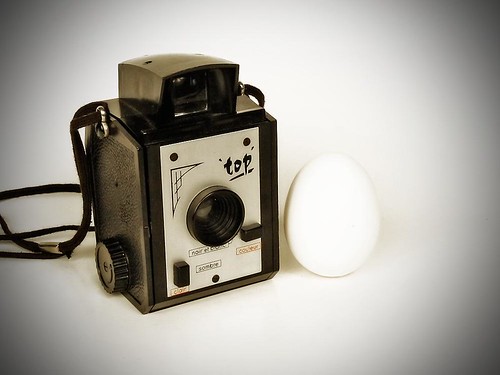Top (4x4)

|
| Model with exposure controls image by Inspiredphotos (Image rights) |
| German, French & Italian Cameras using 127 film | |||
| G e r m a n y |
3×4 | rigid | Dreivier | Futuro | Gewirette | Kolibri Parvola | Pupille | Ranca | Reporter | Puck |
| folding | Baby Ikonta | Baldi | Dolly | Goldi Gucki | Ingo | Korelle | Makinette Metharette | Perkeo | Vollenda | ||
| 4x4 | Navax | Paxina Electromatic | Rothlar | ||
| 4x6.5 | Bella | Billy | Bob | Dolly | Goldi Gucki | Korelle | Panta | Parvola Piccolette | Rio | Ultrix | ||
| TLR | see German TLRs | ||
| F r a n c e |
3×4 | rigid | Fotobaby | Lynx | Super-Boy |
| folding | Derby-Lux | Elax | ||
| pseudo TLR | Auteuil | Longchamp | ||
| 4×4 | rigid | Impera | Marly | Pari-Fex | Rubi-Fex | Top | |
| 4×6.5 | rigid | Photo-Magic | |
| I t a l y |
3x4 | Comet | Comet III | Cometa | Euralux Ibis | Maxima | Piccolo | Tanit | |
| 4x4 | Comet | Euralux | Ibis | ||
| 4x6.5 & other | Alfa | Delta | Relex | Rolet | Rondine | ||
The Top is a plastic-bodied box camera for 4x4 cm pictures on 127 film, made in France in about 1960.[1] The maker of the camera is not known; the packaging is marked with a logo that might be read as the letters J, P and C, and the notes at Collection d'Appareils suggest without explanation that the camera may have been made in Lons le Saunier, in the Jura departement.[1] The packaging is marked 'Licence "PRECIDES"'. Précidès is the name used by the company MAPED for its one camera, and other products including a toy microscope, so it seems likely that MAPED designed the Top, and sold the design to another maker. MAPED made office and school supplies (scissors, staplers, etc) its main business.
The body of the Top is moulded in black plastic, with a plate covering most of the front, surrounding the lens. Some examples have leatherette on the sides;[2] others have a leather-grain moulded into the plastic body.[3] It has a rather large reverse-Galilean viewfinder at the top, a winding knob on the right side, and lugs for a cord strap.
There are two types. The better-specified type has two lever controls for exposure on the front plate,[1] which is metal in this model.[4] These are marked 'noir et blanc'/'couleur' and 'sombre'/'clair'; in fact, one selects between two shutter speeds, and the other between two fixed aperture stops. In this model, the shutter release is a bar across the whole width of the top of the front panel, making it equally easy to use left- or right-handed. The camera has contacts for a bulb flash holder.[2]
The other type has no exposure controls,and has a simple plunger shutter release on the left of the viewfinder.[3] The front plate is plastic.[4]
Notes
- ↑ 1.0 1.1 1.2 Top; the better-specified model with exposure adjustments, at Sylvain Halgand's Collection d'Appareils Photo.
- ↑ 2.0 2.1 Top in an outfit with a bulb flash, at Collection d'Appareils. This example has leatherette on the sides.
- ↑ 3.0 3.1 Top; the simple model with no exposure controls, and moulded grain-pattern sides, at Collection d'Appareils.
- ↑ 4.0 4.1 McKeown, James M. and Joan C. McKeown's Price Guide to Antique and Classic Cameras, 12th Edition, 2005-2006. USA, Centennial Photo Service, 2004. ISBN 0-931838-40-1 (hardcover). ISBN 0-931838-41-X (softcover). p928.